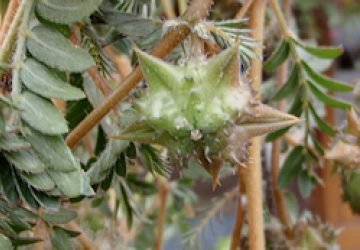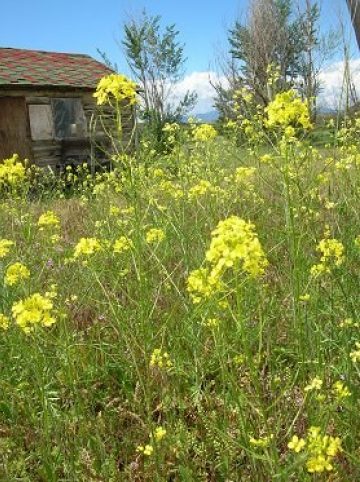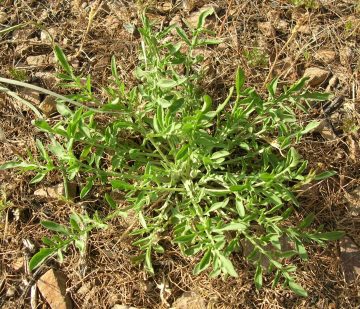If there’s one thing that makes weeds impressive it’s that they can survive. Granted, noxious weeds have a leg up because they don’t have the natural predators here that they once had on their home continents. But even still, these highly evolved plants that we love to hate have figured out how to grow and spread quickly, persist in a wide range of conditions and out-compete many (but not all!) native plants. This is a daunting realization when you are staring at a creeping expanse of white-top like it's The Blob, and we’ll be the first to tell you that weeds in the Methow should be accepted as a fact of life - you are never going to permanently eradicate all of them from your land.
It’s
also a fact of Methow life that weed control is important and very
do-able. By learning some basic information about weeds, prioritizing
your time and efforts, and taking a multi-pronged approach to fighting
weeds, you can find the balance in controlling weeds and giving native
plants a chance to thrive.
The Top Ten Tools of the Weed Control Trade
To solve a problem well you often have to come at it from
multiple angles. The same is true with getting rid of weeds - using
one weed control method is rarely effective. You might see or hear the
terms “Integrated Weed Management” or “Integrated Pest Management” in
your battle against weeds. This simply means to use a combination of
tools based on the types and numbers of weeds you have, the size of
your site, your goals and capabilities. Here’s our list of ten
effective ways to prevent, reduce and manage the spread of weeds.
Tool #1 - Educate Yourself
Identify which weeds grow on your land
and collect some basic information about each weed’s life cycle. You
can use our online weed guide and use our Additional Weed Control Resources
page for a list of books and local experts. Call or email us with
questions; stop by our Weed & Native Plant Education Booth that’s
at the Twisp Farmers Market every year from mid-May to mid-June; or hire
us to do a weed inventory on your property. Talk to your neighbors
as they might be dealing with the same weeds and can give you
first-hand tips.
Before you start spending every afternoon pulling cheatgrass, prioritize
your work by going after the “noxious”, highly invasive weeds first
and catching new invaders before they spread. Make a simple plan for
yourself by listing and prioritizing all the weeds you know of, perhaps
even plotting their locations on a basic sketched map of your
property. If you have a large property or a lot of weeds, create a
realistic zone or just pick one weed (after you’ve prioritized your
weeds!) that you can focus on, and simply leave the rest of the property
alone until you are ready to tackle more.
Tool #2 - Plant Competing Vegetation
Planting non-weeds (a native plant or a cultivated variety
that will do well here and won’t become weedy) is the best way to
control weeds. Promptly fill any disturbed soil with desirable plants
or seeds, whether it’s after you’ve built a driveway or after a
session of weed-pulling. It’s handy to always have a bag of native
grass or wildflower seed at the ready so that you can sprinkle seeds
onto exposed dirt. See the Additional Weed Control Resources for where to get seeds and plants.
Tool #3 - Pull Weeds by Hand
Hand pulling is an excellent way to control any weed with a
taproot or shallow root system (these are typically annuals and
biennials but not always). Ideally, you should pull them throughout
the spring and early summer, when the soil is moist, and before seeds
form. Make an effort to get the entire root system out of the ground.
Plants without seeds can be left on the ground or piled and composted.
Plants that have flowered should be bagged and put in the trash, or
burned, because there’s a chance they’ve already gone to seed. Hand
pulling creates small soil disturbances; consider reseeding as you
weed.
Tool #4 - Hoeing
Hoeing works well for annual weeds with weak roots,
especially very young seedlings. People commonly use either scuffle
or stirrup hoes in garden beds or aisles, and then pick up the loosened
weeds. Again, the bare, loose soil can create favorable conditions
for new weeds to sprout, so either reseed or mulch or cover the soil
(with newspaper or cardboard, e.g.) after hoeing.
Tool #5 - Work the Soil
Cultivation - tilling, discing or plowing - is used on
large-scale agricultural lands. It’s a great way to kill certain weeds,
especially when it is followed by a planting of a cover crop to
compete with weeds and recondition soil prior to agricultural use (or
native plant restoration). Usually, repeated cultivation is necessary
to reduce weed seed banks and prevent new weeds from establishing.
Tilling or breaking up the soil is almost never advocated when there
are rhizomatous weeds present, unless you can commit to regular
cultivation. Weeds like quackgrass, whitetop, and Russian knapweed
spread via any part of their root and cultivation breaks their roots
into many tiny pieces, effectively spreading them like wildfire.
Tool #6 - Mowing
Mowing can effectively reduce seed production but timing is
critical. Mow when plants have begun blooming but have not yet set
seed - it’s usually a very short window, especially for grass species.
Plan to mow more than once because different weeds bloom at different
times and some species react by sending out flowering shoots at ground
level. Weed whackers, heavy-duty mowers, and tractor mowers work well
for this. Take care to avoid harming native plants.
Tool #7 - Covering Soil
Plastic sheets are often used to convert weedy soil to soil
that’s ready to be cultivated. There are a variety of types
available, and non-plastic coverings, like newspaper, cardboard, or
thick layers of mulch can also be effective on small areas such as
flower or vegetable gardens. Woven black plastic (also known as
landscape fabric or weed barrier) allows air and water to pass through,
preserving beneficial microorganisms in the soil below, but reduces
light and heat which any plant, even weeds, need to survive. Very tough
weeds like quack grass will grow right through woven plastic; for
these weeds use solid plastic sheets. Plastic sheets do not always kill
weed seeds in the soil.
Tool #8 - Grazing Animals
Grazing was used for weed control in the past and is making
a bit of a comeback today. Within portable fences, moved often,
small herds of sheep or goats (even one or two animals) can control weed
species by eating them. Grazers often prefer young, tender plants
but with careful planning, monitoring and frequent moving you could
keep a lot of weeds from blooming throughout the spring and summer.
Tool #9- Biocontrols (Miniature Grazing Animals)
Biocontrols (aka bioagents or biological control agents),
are typically very small plant-eating insects imported from a
particular weed’s native land. Extensive research and tests done by the
USDA and state extension agencies have resulted in the successful use
of numerous biocontrols that are available to the public. Many
biocontrols are “weevils;” these tiny beetles burrow into a plant’s
stem, root, or seed-head and eat. Here in the Methow Valley, the
“knapweed seedhead weevil,” Larinus minutus, is quite a popular “tool” for successfully reducing knapweed.
Biocontrols are most
effective on sizable populations of target weeds, at least an acre or
more. Weevils will only stay where you put them if there is enough
"food" for them to eat, so they move around depending on weed
infestations. The good news is that so many knapweed weevils have been
released in the Methow over the last 10+ years that you might already
have some. Split open a knapweed seed-head this summer and see if you
can see a little black beetle!
The Regional Biocontrol Project run through the Ferry County Extension office for both Okanogan and Ferry counties, is the source of FREE
biological agents (aka biocontrols) for certain weeds, such as St.
Johnswort, diffuse & spotted knapweed, Dalmatian and yellow
toadflax, and Canada and musk thistle. If you have a sizable
infestation of any of these weeds on your property, one acre or more,
it’s worth looking into this resource. Biocontrols are available on a
first-come, first-serve basis. Go to the website or contact Dale
Whaley, 509-745-8531.
Tool #10 - Herbicides
Herbicides present difficult questions for backyard
stewards and gardeners. They can be effective weed killers but their
negative side effects on human health and our ecosystem can be huge.
We advocate using herbicides only after other methods have been
explored, and only for the toughest weeds such as Russian knapweed and
whitetop.
Different products bring
varying levels of risk. Weigh the pros and cons, talk to local experts,
and make an informed decision. The Okanogan County Noxious Weed Control Board
is a great place to start. Ask them which herbicide to choose, which
licensed applicator to hire, or courses offered in homeowner
application. They even offer free on-site consultations. |



